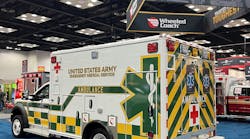April 26 -- HOLLAND, MI -- With a 9 percent increase in calls for service last year, the Holland Fire Department is looking ahead to try and meet the growing needs of its community.
The fire department responded to 3,857 incidents in 2017, up 320 calls from 2016. Of those 320 additional calls, most of them were calls for medical emergencies.
"If you look at the increased ebb and flow, those increases have been since 2014," said Holland Fire Department Capt. Chris Tinney. "Overall, just over two-thirds are medical."
Tinney said the department is responding to about 800 more calls per year than they were in 2014. In order to better respond to the additional medical service calls, the Holland Fire Department has made some improvements to its services.
In 2017, the department received two devices that give automatic chest compressions to someone experiencing a cardiac emergency. After a while, a human can become tired and begin giving less consistent CPR compressions. With the new automated machines, that won't be the case.
"We've had them since August and they increase consistency," said Holland Fire Marshal Bret Groendyke. "Anecdotally, we can say we're giving everything we can to the patient."
Along with the new chest compression tools, the Holland Fire Department started carrying a more cost-effective version of epinephrine to treat severe allergic reactions. Previously, the department has carried epinephrine injector pens, like EpiPens. Those types of injectors, though, can be as expensive as $700 per pen and the fire department carried injectors on each vehicle, costing up to $16,800 for the department.
Now, the department carries vials of epinephrine that can be injected into a patient using a needle, like how a vaccine is administered. The vial kits cost $15, saving the department thousands of dollars.
"We wanted to expand the scope of practice and it came about because of the (cost) spike in medications," Tinney said. "We're already trained in injections now, so we can expand that in the future. We play a significant role in EMS in the community and if we can better that service, we're going to do it."
During 2017, the fire department saved nine lives by administering Narcan, a drug that stops someone from dying while in the throws of a drug overdose. The department has been carrying Narcan for a few years, but Tinney said they've seen a significant increase in need for the drug.
"I think it's just indicative of the opioid crisis," Tinney said. "We're using it more because it's available, and it also shows a problem. It's indicative of a trend and our use has definitely gone up over the years."
Throughout 2017, the fire department responded to 103 fires, similar to the number of fires in previous years. In those 103 fires, $1.238 million of property was lost. That's the highest dollar value of property loss since 2009, but much of that spike can be accounted for by a commercial fire in November that destroyed a recycling building on 19th Street. Overall, 98.43 percent of property exposed to fires was saved during the year.
"There's a lot that goes into property loss and we do a pretty good job of protecting property," Tinney said. "Commercial properties are valued higher, but that's from year to year."
However, with the scope of the fire department expanding, there are several areas of improvement Tinney and his team identified in the department's 2017 annual report.
First, the department is looking to make some improvements to the fire stations to better suit the firefighters' needs. The fire station on Waverly Road only has one bathroom, serving male and female firefighters that work 48-hour shifts. In the near future, the department hopes to have separate bathroom facilities for male and female employees.
The department also does not have a designated area to decontaminate its EMS equipment, according to the annual report.
"We do not have appropriate facilities for decontamination of equipment and restocking of items that were used on scene. Our EMS equipment is stored in the cleaning closet," the report reads. The department is also asking for a separate storage area to keep firefighting gear, in order to keep potential carcinogens away from the firefighters while at the stations. Right now, that firefighting gear is kept in a common area in the station garage, then sent out to be cleaned.
"We're still recovering from the economic downturn, but some of our buildings need some updates," Tinney said. "What we really need is a good plan. Funding will eventually go into a building project, but we understand there's only so much to go around."
The fire department has already begun conversations with an architect about what the possibilities are for reconfiguring the fire stations for current needs, but actual construction is probably still a few years away.
"Carcinogens are playing a much larger role in firefighter cancer than we thought — and that's huge," Tinney said. "The same thing with EMS. We need to treat equipment every day and being able to have a work surface designed for that is important. Our initial thought is that most of the work would occur out at Waverly."
That work, though, won't happen until 2020 or 2021, Tinny said. In the meantime, the fire department is also looking at replacing one of its fire trucks. The truck, which has an aerial ladder on it, has been in use for 16 years. The average lifespan of a fire engine is around 20 years old, but the aerial truck is excessively rusting and the uniqueness of the aerial ladder has caused problems for the department. The ladder was made in Finland, and finding technicians that can repair the ladder is increasingly difficult. So far, the department has spent $185,000 on repairs for the truck.
"If that truck was unsafe, it wouldn't be out on the road, but it's a challenge to maintain," Tinney said. "When you look at responding to overlapping calls, we have to run medical calls on larger apparatus and these are rolling tool boxes. It's important to have those tools."
Replacing an aerial truck can easily cost $1.2 million. In theory, each vehicle owned by the fire department is supposed to have a certain amount of money put aside for replacement by the city of Holland. That vehicle replacement fund is supposed to grow by $100,000 each year, but that hasn't necessarily happened.
"There were years where that amount was reduced, and one year where we didn't put anything in it," Tinney said. "We knew it was a risk. (City) council knows where we're at and want to get it addressed."
In the 2019 fiscal year budget, the fire department is expected to receive $250,000 for the vehicle replacement fund and an additional $50,000 for maintenance repairs at the Waverly fire station. That budget, which will take effect on June 30 of this year, is awaiting approval by Holland city council. A vote on the budget will take place at its Wednesday, May 2, meeting.
Tinney said the $250,000 "will start to do some catch-up," but it will take a couple more years until the department has enough funding to order a new fire engine.
"Right now, council hopefully will authorize those expenditures in the future," he said. "I see the bills, I see the maintenance costs.
"It's OK to talk about our challenges, but we better have solutions."
___
(c)2018 Holland Sentinel, Mich. Visit Holland Sentinel, Mich. at www.hollandsentinel.com Distributed by Tribune Content Agency, LLC.






